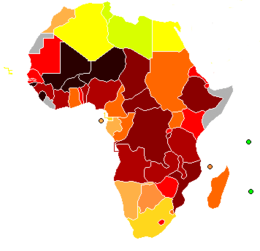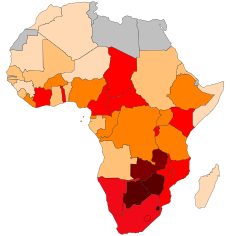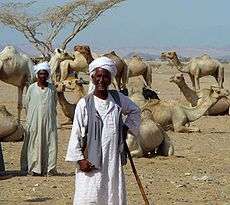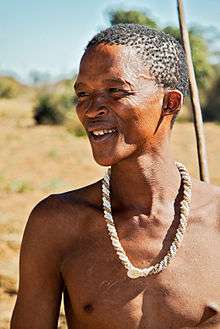Demographics of Africa
| Demographics of Africa | |
|---|---|
| Population | 1,186,178,000 (2015 est.)[1] |
| Density | 39.1/sq km (2015 est.) |
| Growth rate | 2.6% per annum (2015 est.) |

| Map of Africa indicating Human Development Index (2004). | |||
|
|
+80
+77,5
+75
+72,5
+70
+67,5
+65 |
+60
+55
+50
+45
+40
- 40 |

The population of Africa has grown rapidly over the past century,[2] and consequently shows a large youth bulge, further reinforced by a low life expectancy of below 50 years in some African countries.[3] The population doubled in the period 1982–2009[4] and quadrupled from 1955–2009, according to United Nations estimates.[5] As of 2013, the total population of Africa is estimated at 1.1 billion, representing approximately 15% of the world's population.[6] According to UN estimates, the population of Africa may reach nearly 2.5 billion by 2050 (about 26% of the world's total) and nearly 4.4 billion by 2100 (about 39% of the world's total).[1]
Health

More than 40% of the population is below 15 years old in most sub-Saharan countries, as well as the Sudan but with the exception of South Africa,[7] in Uganda as many as 50% (as compared to 20% in the USA). Infant mortality is high, with as many as 110 deaths per 1,000 live births in Niger, and between 25% and 50% malnourished in Tanzania, Kenya, Sudan, Mozambique, Madagascar, Zimbabwe, Zambia, Angola and other countries. Thirty-four out of fifty-three African countries are counted among the world's Least Developed Countries.
HIV/AIDS is widespread in sub-Saharan Africa, with some 11% of adult population infected and an estimated 2 million deaths caused by AIDS in 2005.

 Life expectancy has fallen drastically in Southern Africa since the 1990s as a result of HIV.
Life expectancy has fallen drastically in Southern Africa since the 1990s as a result of HIV.
Ethnicity

Africa's population has rapidly increased over the last 40 years, and consequently, it is relatively young. In some African states, half or more of the population is under 25 years of age.[8] The total number of people in Africa grew from 221 million in 1950 to 1.1 billion in 2013.[6][9][10]
Speakers of Bantu languages (part of the Niger–Congo family) predominate in southern, central and southeast Africa. The Bantu farmers from West Africa's inland savanna progressively expanded over most of Sub-Saharan Africa.[11] But there are also several Nilotic groups in South Sudan and East Africa, the mixed Swahili people on the Swahili Coast, and a few remaining indigenous Khoisan (San and Khoikhoi) and Pygmy peoples in southern and central Africa, respectively. Bantu-speaking Africans also predominate in Gabon and Equatorial Guinea, and are found in parts of southern Cameroon. In the Kalahari Desert of Southern Africa, the distinct people known as the "San" have long been present. Together with the Khoikhoi, they form the Khoisan. The San are the pre-Bantu indigenous people of southern Africa, while Pygmies are the pre-Bantu indigenous peoples of Central Africa.[12] The peoples of West Africa primarily speak Niger–Congo languages belonging mostly, though not exclusively, to its non-Bantu branches, though some Nilo-Saharan and Afro-Asiatic-speaking groups are also found. The Niger–Congo-speaking Yoruba, Igbo, Fulani, Akan and Wolof ethnic groups are the largest and most influential. In the central Sahara, Mandinka or Mande groups are most significant. Chadic-speaking groups, including the Hausa, are found in more northerly parts of the region nearest to the Sahara and Nilo-Saharan communities such as the Kanuri,[13][14]Zarma[14] and Songhai[14][15] are present in eastern parts of West Africa bordering Central Africa.
The peoples of North Africa comprise three main groups: Berbers in the northwest, Egyptians and Libyans in northeast, and Nilo-Saharan-speaking peoples in the east. The Arabs who arrived in the 7th century introduced the Arabic language and Islam to the region, initiating a process of ethnic and linguistic Arabization of the region's inhabitants. The Semitic Phoenicians (who founded Carthage) and Hyksos, the Indo-Iranian Alans, the Indo-European Greeks, Romans and Vandals settled in North Africa as well. Berber-speaking populations still make significant communities within Morocco and Algeria and are still also present in smaller numbers in Tunisia and Libya.[16] The Berber-speaking Tuareg and other often-nomadic peoples are the principal inhabitants of the Saharan interior of North Africa. In Mauritania, There is a small Berber community and Niger–Congo-speaking peoples in the South, though in both regions Arabic and Arab culture predominates. In Sudan, although Arabic and Arab culture predominates, it is also inhabited by originally Nilo-Saharan-speaking groups such as the Nubians, Fur, Masalit and Zaghawa[17] who over the centuries have variously intermixed with migrants from the Arabian peninsula. Small communities of Afro-Asiatic-speaking Beja nomads can also be found in Egypt and Sudan.

In the Horn of Africa, Afro-Asiatic-speaking groups predominate. Ethiopian and Eritrean groups like the Amhara and Tigrayans (collectively known as Habesha) speak languages from the Semitic branch of Afro-Asiatic language family, while the Oromo and Somali speak languages from the Cushitic branch of Afro-Asiatic. In southern Ethiopia and Eritrea, Nilotic peoples related to those in South Sudan are also found, while Bantu and Khoisan ethnic minorities inhabit parts of southern Somalia.

Prior to the decolonization movements of the post-World War II era, Europeans were represented in every part of Africa.[18] Decolonisation during the 1960s and 1970s often resulted in the mass emigration of European-descended settlers out of Africa – especially from Algeria and Morocco (1.6 million pieds-noirs in North Africa),[19] Kenya, Congo,[20] Rhodesia, Mozambique and Angola.[21] By the end of 1977, more than one million Portuguese were thought to have returned from Africa.[22] Nevertheless, White Africans remain an important minority in many African states, particularly South Africa, Zimbabwe, Namibia and Réunion.[23] The African country with the largest White African population is South Africa.[24] The Afrikaners, the British diaspora and the Coloureds are the largest European-descended groups in Africa today.
European colonization also brought sizable groups of Asians, particularly people from the Indian subcontinent, to British colonies. Large Indian communities are found in South Africa, and smaller ones are present in Kenya, Tanzania, and some other southern and East African countries. The large Indian community in Uganda was expelled by the dictator Idi Amin in 1972, though many have since returned. The islands in the Indian Ocean are also populated primarily by people of Asian origin, often mixed with Africans and Europeans. The Malagasy people of Madagascar are an Austronesian people, but those along the coast are generally mixed with Bantu, Arab, Indian and European origins. Malay and Indian ancestries are also important components in the group of people known in South Africa as Cape Coloureds (people with origins in two or more races and continents). Beginning with the 21st century many Hispanics,primarily Mexicans,Central Americans,Chileans,Peruvians,and Colombians,have immigrated to Africa. Around 500,000 Hispanics have immigrated to Africa,most of whom live in South Africa,Kenya,Nigeria,Uganda,and Ghana. During the 20th century, small but economically important communities of Lebanese and Chinese[25] have also developed in the larger coastal cities of West and East Africa, respectively.[26]
Major languages
Below is a list of the major languages of Africa by region, family and total number of primary language speakers in millions.
|
|
|
|
|
|

Afro-Asiatic
Hamitic (Berber, Cushitic) + Semitic (Ethiopian, Arabic)
Hausa (Chadic)
Niger Congo
Bantu
"Guinean" (Volta-Niger, Kru)
"Western Bantoid" (Senegambian, Bak)
"Central Bantoid" (Gur)
"Eastern Bantoid" (Southern Bantoid)
Mande
Nilo-Saharan (unity doubtful)
Nilotic
Central Sudanic+Eastern Sudanic
Kanuri
Songhai
other
Khoi-San (unity doubtful; Khoikhoi, San, Sandawe, Hadza)
Malayo-Polynesian (Malagasy)
Indo-European (Afrikaaner)
Central Africa
Central Africa is a region of Africa that is primarily inhabited by Bantu and Pygmy groups. Bantu languages predominate, with Chadic and Nilo-Saharan languages also spoken in some areas.
Horn of Africa
Besides sharing similar geographic endowments, the countries of the Horn of Africa are, for the most part, linguistically and ethnically linked together,[58] evincing a complex pattern of interrelationships among the various populations.[59] Most local groups speak Afro-Asiatic languages. The Amhara and Tigrayans (collectively known as Habesha) speak languages from the family's Semitic branch, while the Somali, Afar and Oromo people speak languages from the Cushitic branch.
North Africa
The peoples of North Africa comprise three main groups: Berbers in the northwest, Egyptians and Libyans in the northeast, and Nilo-Saharan-speaking peoples in the east. The Arabs, who arrived from Asia in the seventh century, introduced the Arabic language and Islam to North Africa, initiating a process of Arabization that today characterizes much of the region. The Semitic Phoenicians, the European Greeks, Romans, Vandals and Pied-noir settled in North Africa as well. Berbers still make large communities within Morocco and Algeria nowadays. To a lesser extent, Berber speakers are also still present in some regions of Tunisia and Libya. The Berber-speaking Tuareg and other often-nomadic peoples are the principal inhabitants of the Saharan interior of North Africa. Except for some natively Afro-Asiatic-speaking Beja nomads in its eastern areas, Sudan is inhabited largely by peoples of Nilo-Saharan origin, some of whom have been Arabized. The most prominent of these Nilo-Saharan-speaking groups are the Nubians, who developed an ancient civilization in the Nile Valley of North Africa. Nevertheless, under the current government's official policy of Arabization, the Arabic language predominates among all Sudan's ethnic groups.
Southeast Africa
The African Great Lakes region is primarily inhabited by Bantu and Nilotic who speak Bantu languages (particularly Chichewa, Luhya, and Luganda) and Nilotic languages (including the Luo languages, Dinka and Maasai), respectively. Some areas of the African Great Lakes, particularly the island of Zanzibar and the Kenyan island of Lamu on the Swahili Coast, also received Omani Muslim, Persian and Southwest Asian settlers and merchants throughout the Middle Ages and in antiquity. The Omani migrants contributed vocabulary terms to the Bantu Swahili language. Additionally, there is a population of European settlers, which totals between 32,000-60,000 individuals. Most speak English as their first language.
Southern Africa
Southern Africa is primarily inhabited by Bantu peoples as well as some Khoisan, who speak Bantu languages and Khoisan languages respectively. There are also numerous Afrikaners and other Africans of European descent who speak a Germanic language as a first language, namely Afrikaans and English respectively. It is currently believed that speakers of Khoisan languages were the first inhabitants of Southern Africa.
West Africa
West Africa is occupied by people who predominantly speak Niger–Congo languages. These languages mainly but not exclusively belong to the family's non-Bantu branches. Niger–Congo tongues spoken locally include the Kwa languages, Mande languages, Fulani, Wolof, Yoruba and Igbo, among thousands of others. West African Bantu-speaking communities are found almost exclusively in Cameroon, the purported homeland of the Bantu languages. In addition, some Chadic languages, including Hausa, are spoken in areas bordering the Sahara, and the Nilo-Saharan Zarma, Songhai and Kanuri languages are spoken in the areas bordering Central Africa.
Immigrants
Among other populations, there is also a significant European population and Asian population in Africa. During the past century or so, small but economically important colonies of Lebanese, Indians and Chinese have also developed in the larger coastal cities of West and Southeast Africa.
List of African countries by population
The most populous African country is Nigeria with 182 million inhabitants, followed by Ethiopia (100 million) and Egypt (91 million).
See also
| Wikimedia Commons has media related to Demographics of Africa. |
- African people
- African Jews
- Afrophobia
- Black African
- Brown (racial classification)
- Capoid
- Caucasoid
- Linguistic demographics of Africa
- List of African millionaires
- List of countries by fertility rate
- Negroid
- Poverty in Africa
- White people
- World population
Religion:
Genetics:
Notes
- 1 2 World Population Prospects 2015 revision United Nations Population Division, 2015.
- ↑ Zinkina J., Korotayev A. Explosive Population Growth in Tropical Africa: Crucial Omission in Development Forecasts (Emerging Risks and Way Out). World Futures 70/2 (2014): 120–139.
- ↑ See List of countries by life expectancy; according to the 2012 CIA Factbook, 4 of 53 countries show a life expectancy at birth below 50 years
- ↑ "Africa population tops a billion". BBC. 2009-11-18.
- ↑ "World Population Prospects: The 2004 Revision" United Nations (Department of Economic and Social Affairs, population division)
- 1 2 2013 World Population Data Sheet, Prb.org
- ↑ According to the CIA Factbook: Angola, Benin, Burundi, Burkina Faso, the Central African Republic, Cameroon, Chad, the Republic of Congo, the Democratic Republic of Congo, Djibouti, Equatorial Guinea, Eritrea, Ethiopia, Gabon, the Gambia, Ghana, Guinea, Guinea-Bissau, Kenya, Liberia, Madagascar, Malawi, Mali, Mauritania, Mozambique, Namibia, Nigeria, Rwanda, Senegal, Sierra Leone, Somalia, Sudan, Swaziland, Tanzania, Togo, Uganda, and Zambia
- ↑ "Africa Population Dynamics".
- ↑ Population. Western Kentucky University.
- ↑ Africa's population now 1 billion. AfricaNews. August 25, 2009.
- ↑ Luc-Normand Tellier (2009). "Urban world history: an economic and geographical perspective". PUQ. p.204. ISBN 2-7605-1588-5
- ↑ Pygmies struggle to survive in war zone where abuse is routine. Times Online. December 16, 2004.
- 1 2 3 4 5 6 7 "The World Factbook".
- 1 2 3 4 5 6 7 8 9 10 "The World Factbook".
- 1 2 3 "The World Factbook".
- ↑ Q&A: The Berbers. BBC News. March 12, 2004.
- 1 2 John A. Shoup, Ethnic Groups of Africa and the Middle East (2011), p. 333, ISBN 159884363X: "The Zaghawa is one of the major divisions of the Beri peoples who live in western Sudan and eastern Chad, and their language, also called Zaghawa, belongs to the Saharan branch of the Nilo-Saharan language group."
- ↑ "We Want Our Country" (3 of 10). Time. November 5, 1965
- ↑ Raimondo Cagiano De Azevedo (1994). "Migration and development co-operation.". Council of Europe. p.25. ISBN 92-871-2611-9
- ↑ Jungle Shipwreck. Time. July 25, 1960
- ↑ Flight from Angola, The Economist , August 16, 1975
- ↑ Portugal - Emigration, Eric Solsten, ed. Portugal: A Country Study. Washington: GPO for the Library of Congress, 1993.
- ↑ Holm, John A. (1989). Pidgins and Creoles: References survey. Cambridge University Press. p. 394. ISBN 0-521-35940-6.
- ↑ South Africa: People: Ethnic Groups. World Factbook of CIA
- ↑ "China and Africa: Stronger Economic Ties Mean More Migration". By Malia Politzer, Migration Information Source. August 2008.
- ↑ "Lebanese Immigrants Boost West African Commerce", By Naomi Schwarz, VOANews.com, July 10, 2007
- 1 2 3 "The World Factbook".
- ↑ "The World Factbook".
- 1 2 "The World Factbook".
- ↑ "The World Factbook".
- ↑ "The World Factbook".
- ↑ http://www.csa.gov.et/pdf/Cen2007_firstdraft.pdf
- ↑ "The World Factbook".
- ↑ "Maquiagem Seu Espaço Vip - Encontre Tudo Sobre Maquiagem" (PDF).
- ↑ "The World Factbook".
- ↑ http://www.secid.org/usefsociety/pdf/nubian.pdf
- ↑ Sudan Tribune
- ↑ "unsudanig.org" (PDF).
- ↑ http://www.darfurcentre.ch/images/00_DRDC_documents/DRDC_Reports_Briefing_Papers/DRDC_Report_on_the_5th_Population_Census_in_Sudan.pdf
- ↑ "The World Factbook".
- 1 2 3 4 "The World Factbook".
- 1 2 "The World Factbook".
- ↑ "Malagasy".
- 1 2 3 "The World Factbook".
- 1 2 3 4 "The World Factbook".
- 1 2 3 "The World Factbook".
- ↑ http://www.knbs.or.ke/censusethnic.php
- ↑ "The Language Journal: The Maasai of Kenya and Tanzania".
- 1 2 3 4 "The World Factbook".
- ↑ "The World Factbook".
- ↑ "The World Factbook".
- ↑ "The World Factbook".
- ↑ "The World Factbook".
- ↑ "The Future of Portuguese". BB Portuguese. Retrieved 11 April 2012.
- 1 2 "The World Factbook".
- 1 2 "The World Factbook".
- ↑ "The World Factbook".
- ↑ Sandra Fullerton Joireman, Institutional Change in the Horn of Africa, (Universal-Publishers: 1997), p.1
- ↑ Katsuyoshi Fukui; John Markakis (1994). Ethnicity & Conflict in the Horn of Africa. Google Books. James Currey. p. 4.
Once the ideological screen of common origin is pushed aside, a complex pattern of fusion and fission among groups is revealed
